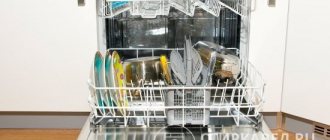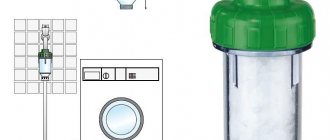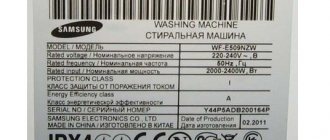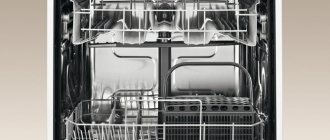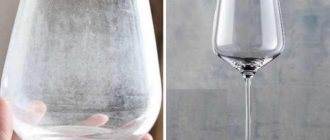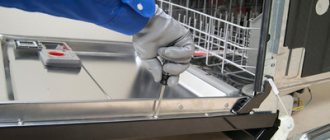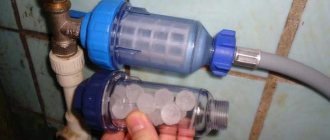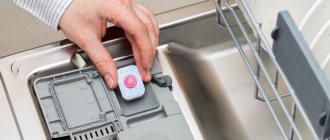Today, more and more housewives are purchasing dishwashers, and this is understandable. After all, such a device saves time, copes with any dirt on dishes and is relatively inexpensive.
But in order for the dishwasher not just to take up space in the kitchen, but to be useful and serve without breakdowns for many years, before you start using it, you should determine the quality of the water entering the house and whether it can be connected to hot water, and also set the appropriate value on the device itself.
What is it for? How to determine water hardness? And what if it is not dishwasher safe?
How to set the degree of hardness in the PMM Bosch sps25fw11r?
Soft water, i.e. Water with a low salt content is the key to high-quality washing of dishes in any dishwasher (DMM). That is why many PMMs have special containers for water softening, including the Bosh SPS25fw11r.
To correctly set the water hardness in the dishwasher, you need to find out the hardness of your tap water (this can be found out at your Vodokanal, or have your water tested for a fee). The Bosh dishwasher has 8 hardness settings: from H:00 to H:07, where H:00 means that the water does not need to be softened. After you have found out the hardness value, you should set the required softening level according to the hardness table (the table is in the PPM operating manual).
Adjusting the hardness in the Bosh SPS25f is done as follows:
- Turn on the dishwasher;
- Press and hold the "A" button. Without releasing the button, press the “Start” button until “H:00” appears on the screen;
- Release both keys and press the “C” key as many times as necessary until you set the required value “H:00 - H:007”;
- After setting the hardness value, press “START” to save the value in the dishwasher’s memory.
Use a mirror
This method will allow you to guess how hard the water is flowing from the tap. But it will not give a specific meaning.
What you will need
- Mirror.
- Pipette.
- Distilled or boiled water.
What to do
Using a pipette, apply a drop of tap and distilled water to a horizontal mirror surface. Wait for the liquid to evaporate. And then analyze the two spots with sediment remaining on the glass.
The more saturated the sediment from tap water is, the more it differs from the almost imperceptible trace of distilled water, the higher the hardness.
Bosch dishwasher setting water hardness
Soft water, i.e. Water with a low salt content is the key to high-quality washing of dishes in any dishwasher (DMM). That is why many PMMs have special containers for water softening, including the Bosh SPS25fw11r.
To correctly set the water hardness in the dishwasher, you need to find out the hardness of your tap water (this can be found out at your Vodokanal, or have your water tested for a fee). The Bosh dishwasher has 8 hardness settings: from H:00 to H:07, where H:00 means that the water does not need to be softened. After you have found out the hardness value, you should set the required softening level according to the hardness table (the table is in the PPM operating manual).
Adjusting the hardness in the Bosh SPS25f is done as follows:
- Turn on the dishwasher;
- Press and hold the "A" button. Without releasing the button, press the “Start” button until “H:00” appears on the screen;
- Release both keys and press the “C” key as many times as necessary until you set the required value “H:00 - H:007”;
- After setting the hardness value, press “START” to save the value in the dishwasher’s memory.
How to set the water hardness in the dishwasher
Today, more and more housewives are purchasing dishwashers, and this is understandable. After all, such a device saves time, copes with any dirt on dishes and is relatively inexpensive.
But in order for the dishwasher not just to take up space in the kitchen, but to be useful and serve without breakdowns for many years, before you start using it, you should determine the quality of the water entering the house and whether it can be connected to hot water, and also set the appropriate value on the device itself.
What is it for? How to determine water hardness? And what if it is not dishwasher safe?
Methods for determining the pH environment
You can find out the hardness of dishwasher water at home using special test strips or salt meters.
Folk remedies do not guarantee the purity of the experiment. You can use home remedies to determine the presence of salts. Soap is often used to determine. To do this, you need to foam a piece with a small amount of water. If foam does not form well, it means that the pH value in the liquid is exceeded.
Testing water with soap
You can brew loose leaf tea in water and evaluate the result. If the drink turns out brown or black, the water is hard.
There are other testing methods that are used in everyday life. However, with their help it is impossible to correctly determine the water hardness for the dishwasher.
A more effective way is test strips. They have four zones that change color after contact with water. The more parts that have changed, the higher the pH level. The test cannot determine the amount of substances in the liquid in numbers.
Water test strips
A more accurate result can be obtained after using a portable salinity meter. The device is able to show the degree of contamination in numerical equivalent, as well as hazardous substances. The salinity meter can be used repeatedly.
Why hard water is dangerous for dishwashers and more
First, you need to understand what the dangers of hard water are. Surely every person at least once in his life has encountered such an unpleasant thing as scale.
Limescale or scale is Mg (magnesium) and Ca (calcium) salts that did not dissolve during the heating of water.
They commonly collect around heating elements in kettles, washing machines, and on the sides and bottoms of cookware used for boiling.
However, it is not correct to think that scale simply increases the heating time of water and spoils the aesthetic appearance of a household appliance. Since the white “sediment” in the dishwasher primarily reduces the service life of the electrical item, which entails considerable expenses.
What to do if problems arise?
Owners of dishwashers that do not set the required hardness level face two main problems:
- on heating elements , which not only spoils the appearance of household appliances, but also greatly increases the risk of rapid breakdown.
- White stains remain on the washed dishes This is especially noticeable on dark and colored opaque glass.
Having discovered these problems, it is necessary to inspect the car, assessing the degree of their severity. If the process has not yet gone too far, you can set the necessary settings and purchase a special solution for dissolving scale. You need to find exactly what is suitable for dishwashers.
Determining water hardness
There are several ways to answer the question: “How hard is the water flowing through the pipes?”
You can determine what kind of water enters the house from the tap using heating.
Important: the more scale that forms during boiling, the more various compounds the water contains (phosphates, nitrites, sulfates, etc.).
“Folk” methods (do not give 100% accurate results):
For this method, you need to prepare two identical vessels with equal volumes and a kitchen scale.
After this, the vessels are filled with liquid from various sources, and both containers are weighed. The lower the final weight (minus the weight of the empty container), the softer the water.
This is the easiest method, since it only requires hands soaked in warm water, a bar of laundry soap or any detergent.
So, if you can barely lather a bar of soap with wet hands, or the detergent poured onto a sponge produces little foam, then this means that the water available is hard.
Although such an experiment takes several days, it does not require any effort.
So, tap water is poured into any glass container and placed in a dry, dark place. After 2-3 days, the initially clear liquid remained clear, but the smell did not appear? This water is soft. In turn, the presence of sediment and unpleasant odor indicates water hardness.
Test strips.
Important: some dishwasher manufacturers, for example Bosch, sell their household appliances complete with similar strips.
The principle of operation of all such test strips is identical: they are immersed in water for a minimum amount of time (from 1 second to 3 seconds) and after drying they acquire a certain color.
After this, dishwasher owners can only compare the resulting result with a special table to determine the degree of water hardness.
To operate, such a salinity meter uses electric current. When immersed in water, the device begins to produce electrons and measure the amount of salts that interfere with the creation of an electric field. The received data is displayed almost instantly.
Approximate Methods
- Pay attention to the rate at which plaque appears on pipes, taps, and mixers. You recently descaled your faucet, how did it get a gray coating again? This means that calcium and magnesium salts exceed the norm.
- Soapiness. Try washing your hands under the tap with laundry soap. If it foams well, the composition of the water is normal.
- Turbidity . Fill the bottle from the tap and place it in a dark place for a day. If sediment has formed below and there is a film on the walls, the salt level exceeds the norm.
- Taste . Some people can tell the difference by taste. It is believed that soft water tastes much better.
- Difference . Fill identical containers from different sources. Weigh which container is heavier, it will contain more impurities.
You can take a simpler route: call the water utility and find out the degree of hardness in your region.
Of course, these methods are very subjective, so they will not give an accurate result.
Tests
Test strips are treated with a reagent that, when lowered into water, shows the degree of hardness. This can be determined by the number of indicators on the strip or by the change in color of the tester. Then the result must be compared with the table in the dishwasher instructions. In accordance with this, it is necessary to set the settings in the machine.
Technique
You can accurately determine the hardness of tap water using a TDS meter . One end of the device on which the sensor is located must be lowered into the liquid. After this, the device will display the chemical composition on the display.
Traditional methods
Using traditional methods, it is easy to determine whether the water in the tap is hard or soft. If a lot of foam quickly forms when washing your hands with soap , then the content of heavy metals is low. For the test, it is better to use laundry soap, which has a minimum of foaming components.
If scale quickly forms in the kettle , this also indicates increased hardness. also check the level by how cloudy the water will be after thawing .
The last method is to pour water into a transparent glass glass and place it in a dark place. If the water is soft, it will remain clear. And if there is a large accumulation of metal salts in the container, a sediment will appear and the liquid will look cloudy.
These methods give a general idea of the degree of hardness, but do not show the quantitative level, which is necessary to set up the dishwasher. The easiest way to get an accurate result is with test strips. Many modern cars from well-known brands come complete with them.
Is it possible to check through a specialized company?
The most accurate value of water hardness level can be found by having it analyzed. It is carried out both by state laboratories belonging to the system of bodies and institutions of Rospotrebnadzor, Vodokanal, Sanitary and Epidemiological Supervision, and by private companies. In the latter case, it is necessary to have accreditation and a license for this type of activity.
Important! To find out the approximate water hardness, you can simply call the Vodokanal of the relevant municipality or go to the institution’s website.
To check the level of hardness, the simplest and cheapest standard analysis is sufficient.
also indicate other basic characteristics of the sample:
- color;
- zap;
- turbidity;
- acid-base balance;
- exact content of calcium, magnesium, iron, sulfur, chlorine salts.
Its cost, depending on the region, is 3000-5000 rubles.
A simple written agreement is concluded with citizens and organizations who contact the laboratory. It indicates the passport details of an individual or the details of a legal entity, and describes the service that the organization undertakes to provide.
It is imperative to have a clause that clearly states the duration of the study.
After the specified time has passed, the applicant is provided with a written response in the prescribed form. The period can range from 3-5 to 8-10 working days.
The contract also specifies the final cost of the analysis. It also includes a sampling procedure by a laboratory specialist, which guarantees the objectivity of the result.
Important! When choosing an organization, you need to ask how long it has been working in this field, and whether it has its own laboratory. If the water is sent for analysis to another institution, such a “transfer” will delay the process.
How to “fight” hard water
Unfortunately, without the use of special devices, a person cannot independently influence the hardness, since such a parameter directly depends on the composition of the soil.
Important: the more calcareous rocks are contained in the soil of a particular region, the harder the water gets into residential buildings .
Of course, no one forbids boiling water to soften it, but in the case of constant hardness this method is ineffective.
Water filters for dishwasher
Do you need a water filter?
Most dishwashers are designed with a partial cleaning system. It includes:
- Deep (coarse) filter, which is installed on the inlet valve. It purifies water from fine dirt, sand, and rust before it enters the machine.
- Built-in ion exchanger. It reduces its hardness, thereby protecting the heating elements of the machine from scale formation, and also improves the quality of washing dishes.
Often these standard means are not enough. A flow-through cleaner cannot handle excessive amounts of heavy metals. The ion exchanger needs constant updating (regular replenishment of special softening salt, which is used in dishwashers). The volume of ionic material is small, so with increased hardness it is consumed much faster.
A complete solution to this problem is to install filters that can both soften water (if it is too hard) and purify it from various impurities.
How to determine which filter is needed? First of all, you need to know the quality of tap water in order to understand what impurities it contains. You can do this in the following ways:
- Conduct laboratory analysis. This method is the most reliable, but expensive. Based on the results obtained in the laboratory, the necessary remedy is selected.
- Use special test strips. With their help you can determine hardness, pH level, etc. The readings from such special devices are less reliable. But there is enough data to determine what kind of cleaner is needed.
- Conduct your own observation. Observe how quickly scale forms in the kettle. Take a closer look at the clarity of the water that comes out of the tap. Perhaps you “catch” a foreign odor in it. Sometimes such information is quite enough to select one or another cleaner.
Having figured out all the “water problems”, you can safely go shopping for additional protection for your equipment.
Softening filters
The choice of softeners is quite large. Polyphosphate or salt devices are popular among users, as they are easy to install and operate.
The design is a plastic flask with a filler (food grade sodium polyphosphate) inside. Softening occurs due to a chemical reaction: polyphosphate salts dissolve in the liquid passing through it and form a protective film. It is this that binds hardness salts and prevents them from settling on vulnerable parts of dishwashers.
Such softeners are installed in the inlet hose, directly in front of the PMM. And their operation consists of timely filling of a new reagent.
It is impossible to install polyphosphate softeners on a public water supply, since the liquid after salt cleaning will become undrinkable.
The following water purifiers for dishwashers have proven themselves:
- Aquaphor Stiron. Inexpensive and economical softener. One fill is enough for approximately 400 washing cycles.
- Prio® New Water B120. The resource of one backfill is enough for six months before replacement (depending on the frequency of use of the equipment).
As an alternative to polyphosphate cleaners, you can use a reagent-free softener with a magnetic operating principle.
Under the influence of a magnetic field, ions of hardness salts lose their properties, therefore, there is simply nothing for the limescale deposit to form from. Such devices have a long service life and high efficiency, but are also very expensive.
You can see how the magnetic cleaner works in the video:
Polyphosphate for water softening
To soften water, the technology of dosing special substances into the water is used that bind hardness salts. A separate group among these substances are polyphosphates, which can be added to water without special dosing pumps.
Polyphosphates are large whitish crystals that are placed in a filter. Water passes through them, polyphosphates gradually dissolve and bind hardness salts. Accordingly, hardness salts do not form scale.
What is sodium polyphosphate?
Sodium polyphosphate appears as colorless glassy transparent plates or white powder.
Chemical formula: (NaPO3)n • H2O
Sodium polyphosphate (or sodium hexametaphosphate) is obtained by dehydrating or melting monosodium phosphate in muffle furnaces with rapid cooling of the melt. This substance is otherwise called “Graham’s salt.”
How does a polyphosphate filter work?
- There are two options for constructing salt filters based on the type of polyphosphate arrangement:
- in the first case, the substance is poured directly into the flask,
- and in the second it is placed in a special container, which is inserted into the flask like a cartridge.
- Also, similar filters are divided into types according to the method of water distribution:
- direct-flow filters drive the entire water flow through the salt substance;
- filters with dispensers distribute the water flow into two parts, one part is purified with polyphosphate and returned to the general flow.
Thus, the water is softened to the desired hardness. Devices with dispensers can have the function of changing the level of water softening, and single-jet filters bring the liquid to a certain, non-adjustable parameter.
